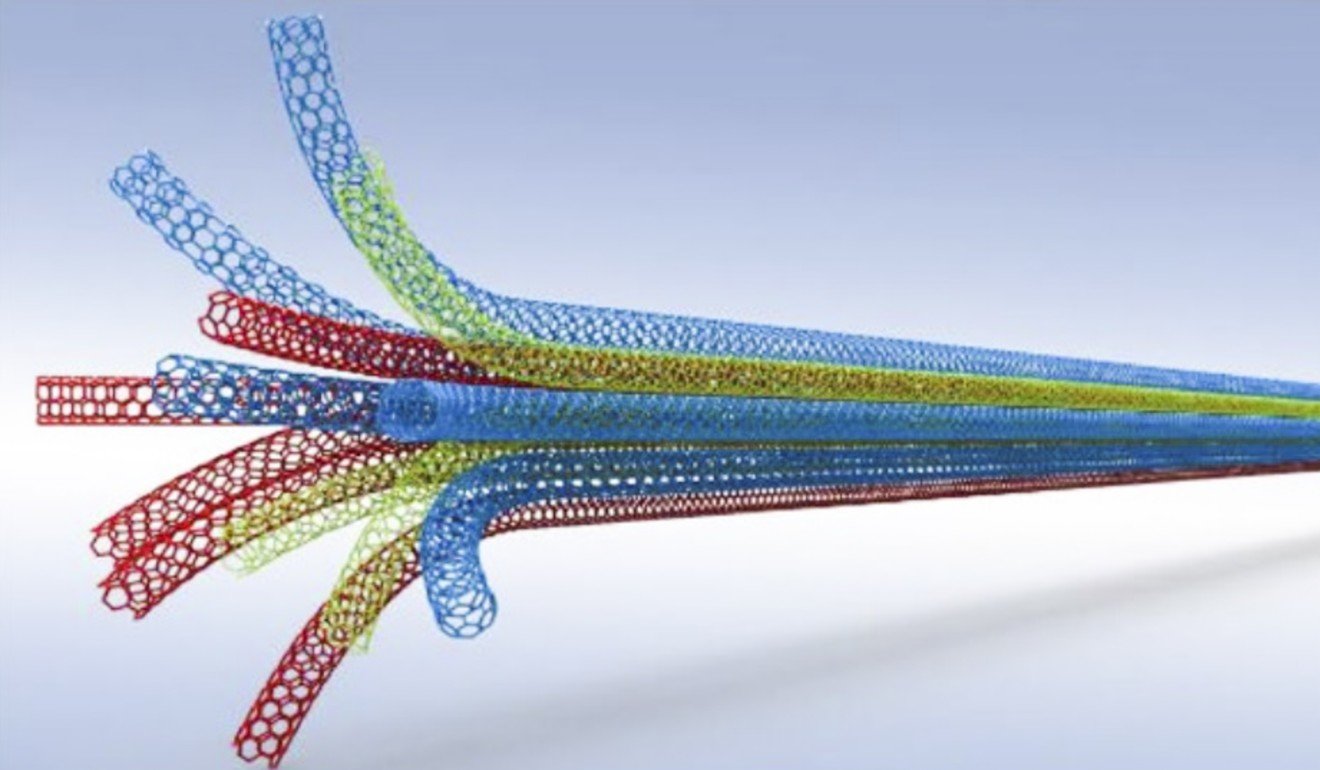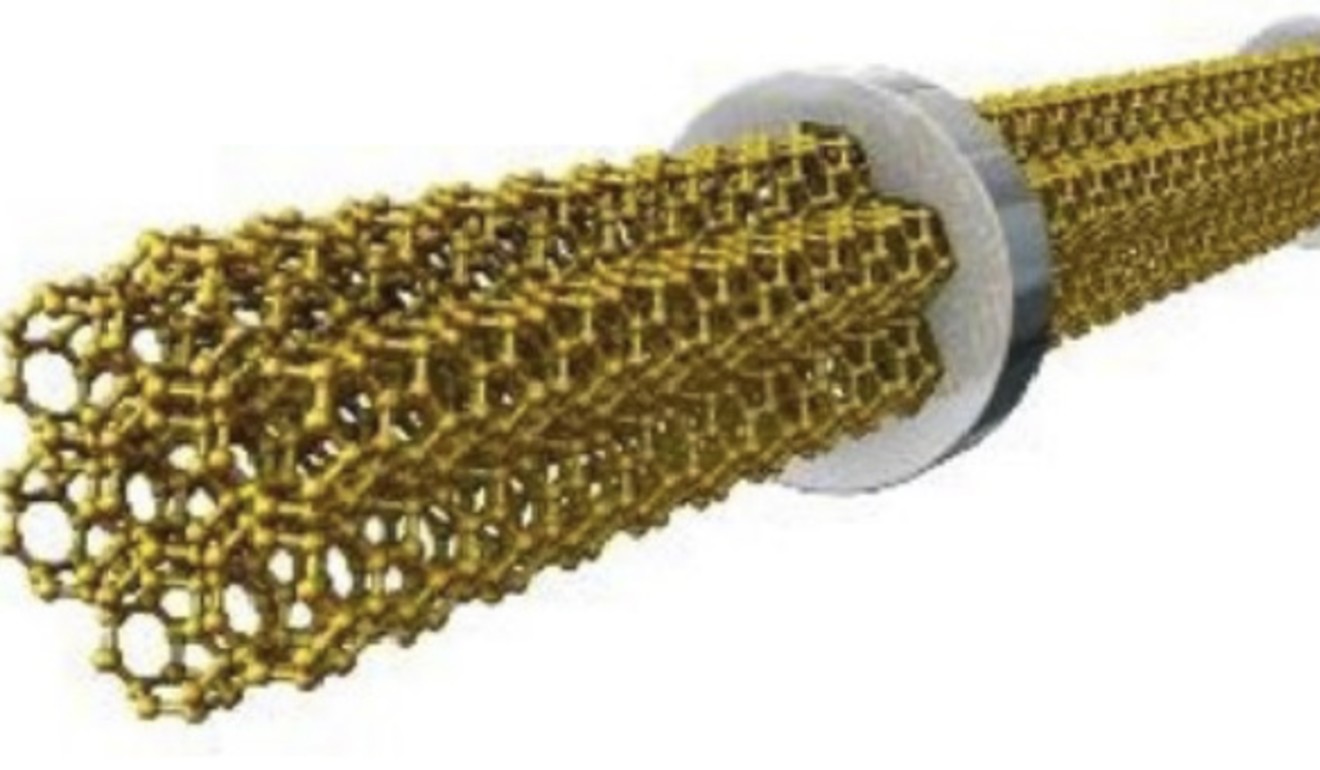
China has strongest fibre that can haul 160 elephants – and a space elevator?
- Scientists say just 1 cubic centimetre of the carbon nanotube material won’t break under the weight of more than 800 tonnes
- Tsinghua University researchers are trying to get the fibre into mass production for use in military or other areas
A research team from Tsinghua University in Beijing has developed a fibre they say is so strong it could even be used to build an elevator to space.
They say just 1 cubic centimetre of the fibre – made from carbon nanotube – would not break under the weight of 160 elephants, or more than 800 tonnes. And that tiny piece of cable would weigh just 1.6 grams.
“This is a breakthrough,” said Wang Changqing, a scientist at a key space elevator research centre at Northwestern Polytechnical University in Xian who was not involved in the Tsinghua study.
The Chinese team has developed a new “ultralong” fibre from carbon nanotube that they say is stronger than anything seen before, patenting the technology and publishing part of their research in the journal Nature Nanotechnology earlier this year.
“It is evident that the tensile strength of carbon nanotube bundles is at least 9 to 45 times that of other materials,” the team said in the paper.
Who needs street lights? Chinese city plans fake moon
They said the material would be “in great demand in many high-end fields such as sports equipment, ballistic armour, aeronautics, astronautics and even space elevators”.
Science fiction?
The idea of building a lift that could travel from the Earth into space may sound like the stuff of science fiction, but it has been around for more than a century, and scientists have come up with various designs in recent decades.
One of them involves sending a large satellite into geostationary orbit that would lower a cable to the ground, where it would be anchored, and send another cable in the opposite direction, attached to a counterweight.
The theory is that the lift would be suspended between two cables – pulled taut by gravity and centrifugal force, and rotating with the Earth, like a weight on a piece of string being swung around in circles.
But so far, the space elevator idea has remained in the realm of physical and mathematical models because there has been no material strong enough to make the super-light, ultra-strong cables needed.
Those cables would need to have tensile strength – to withstand stretching – of no less than 7 gigapascals, according to Nasa. In fact, the US space agency launched a global competition in 2005 to develop such a material, with a US$2 million prize attached. No one claimed the prize.
This could be a game changer in many sectors
Now, the Tsinghua team, led by Wei Fei, a professor with the Department of Chemical Engineering, says their latest carbon nanotube fibre has tensile strength of 80 gigapascals.
Carbon nanotubes are cylindrical molecules made up of carbon atoms that are linked in hexagonal shapes with diameters as small as 1 nanometre. They have the highest known tensile strength of any material – theoretically up to 300 gigapascals.
But for practical purposes, these carbon nanotubes must be bonded together in cable form, a process which is difficult and can affect the overall strength of the final product.
According to Wang, the space lift researcher, the transport system would need more than 30,000km of cable, and it would also need other structures such as a rail and a shield to protect against space debris and other environmental hazards.
“If the cable is not strong enough, it would not even be able to support its own weight. Until now, there has been no material tough enough to do the job,” said Wang, deputy executive director of the China-Russia International Space Tether System Research Centre.
Hotels in space – the final frontier for luxury travel or pure science fiction?
Requirements for cable strength vary according to the space lift design. Wang said the carbon nanotube fibre appeared to be the most promising candidate for now, but more calculations and simulation were needed to evaluate how it would perform.
“The tether is one big problem, but it is not the only problem,” he added.

Chinese and Russian space scientists, for instance, are working together to find a safe, effective way to lower a fine, feather-light cable from a high-altitude orbit to the ground. Re-entry to the atmosphere can produce a lot of heat that could burn the cable, while the counterweight may need to be as large as an asteroid to keep the line straight.
The scale and complexity of such a project would dwarf the International Space Station, according to Wang.
China’s secret 1960s mission to send two dogs into space
But countries including China, the United States, Russia and Japan continue to support the research. So-called space tether technology has the potential to be used for military purposes, including capturing “non-cooperative targets” including enemy satellites.
Japan launched two satellites last month in an experiment to study elevator movement in space – the first time this has been done – involving a mini-lift travelling along a cable from one satellite to another. It has yet to report the results of the experiment. China has also conducted space tethering tests but the details were classified.
Electric cars and laser cannons
While a lift to space could still be many years away, Wei said his team was trying to get the carbon nanotube fibre into mass production for use in defence or other areas.
“This could be a game changer in many sectors,” he said.
Wei gave the example of superfast flywheels in a mechanical battery – where the flywheel stores energy in a rotating mass, lifted by magnetic levitation in a vacuum chamber. The lighter and stronger the material, the faster it spins.
Using carbon nanotube flywheels, the mechanical battery would have 40 times the energy density of a lithium battery, according to Wei. That would mean a car like a Tesla Model S could travel for 16,000km in one charge – the distance from London to Sydney.

But the technology is likely to be used for military purposes first, Wei said.
“Many new weapon systems such as rail guns and laser cannons require high performance power storage and supply systems, and our technology offers a possible solution,” he said.
‘Laser AK-47’? Chinese developer answers sceptics with videos of gun being tested
The researchers made the longest carbon nanotube in the world in 2013 – measuring half a metre – and recently developed a 70cm one.
Song Liwei, who studies mechanical batteries at the Harbin Institute of Technology in Heilongjiang, said if the carbon nanotube fibre could be mass-produced and if it significantly increased the energy density of mechanical batteries, it “would kill fossil fuel engines”.
“But the flywheels can be as big as a barrel, and the fibre would need to be several kilometres long to make a battery,” he said. “There is still a long way to go.”


